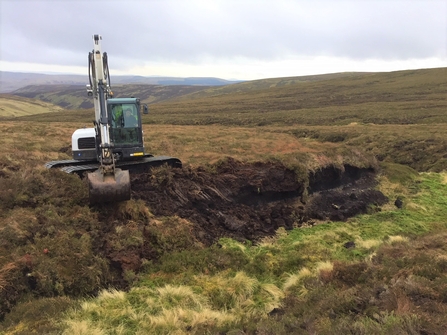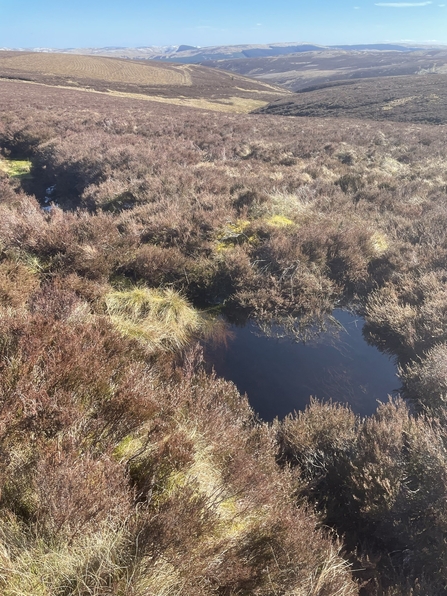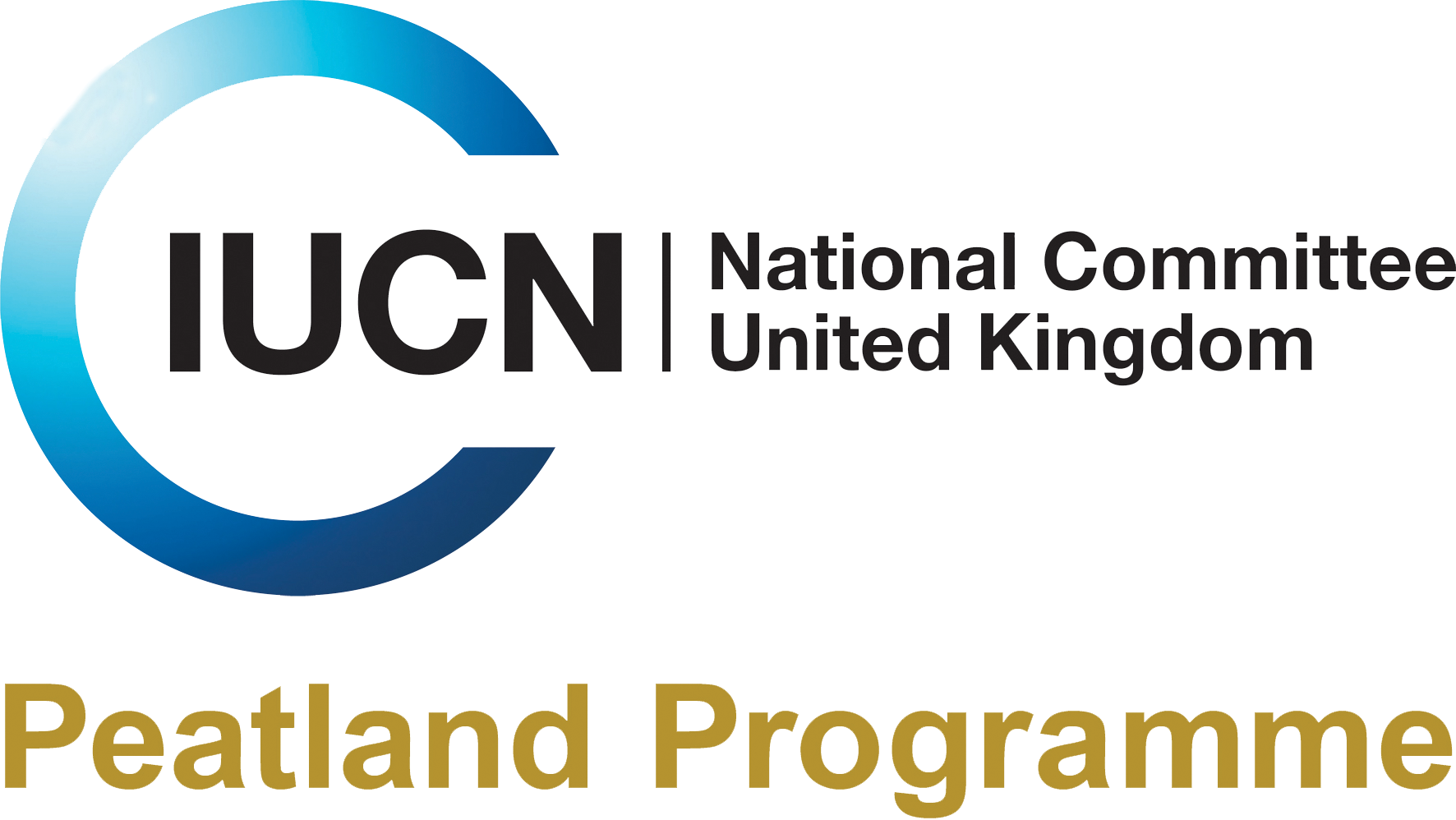This month marks a very important milestone for the IUCN UK Peatland Programme’s Peatland Code, as the very first Peatland Code project also becomes the first verified project under the Peatland Code. Peatland Code projects are verified throughout their lifetime and verified projects are independently assessed as having delivered quantified carbon emission reductions through peatland restoration. This project serves as proof of concept for the voluntary carbon market’s support of peatland restoration in Scotland. The site at Dryhope in the Scottish Borders has utilised both public funding and private investment to deliver lasting benefits to upland blanket bog in the area.
Major milestone in peatland restoration as first blended finance project is verified

Image credit: James Braid (SkyPin)
Peatlands are the world’s largest terrestrial carbon stores, containing more carbon than all other vegetation types combinedThey mitigate flooding, improve water quality, support unique biodiversity and provide an incredible biological and historical archive. However, around 80% of UK peatlands are in a degraded state due to human activity, therefore emitting carbon rather than sequestering it. Peatlands account for around 3.5% of the UK’s greenhouse gas emissions, which is more than the emissions from the entire shipping sector and just under half of the emissions from aviation (8%). Restoration of these ecosystems is essential to achieving the UK’s net zero ambitions and ensuring the many benefits of peatlands are realised.
The Peatland Code is the UK’s only government-backed domestic voluntary carbon standard for quantifying the climate benefits of restoring degraded peatlands. It provides a framework for degraded peatlands to be baselined and for the restoration and long-term sustainable management of that land to be secured for at least 30-100 years. The Peatland Code was created to enable blending of public and private finance for restoration through the sale of carbon credits. It provides a high-integrity, transparent and robust standard which ensures the climate benefits being marketed are real, quantifiable and permanent.
Renée Kerkvliet-Hermans, Peatland Code Manager at the IUCN UK PP, said:
“This first verification is a great achievement, since it shows that the restoration is working and high integrity verified Peatland Carbon Units can be delivered. It is a great step in the continued development of the Peatland Code, under which projects are verified for the first time 5 years after restoration is finished and then as a minimum every 10 years throughout the project lifetime.”
The Office for National Statistics estimates the bill for restoring the UK’s degraded peatlands is in the region of £8-22bn. Public funding alone cannot meet the scale of this challenge and thus private finance needs to be brought in. The UK government has supported the development of the Peatland Code from its initial stages through to version 2.1 which is in use today. Early-adopter projects like Dryhope are vital in showcasing how public and private interests can work together.

Restoration in progress on site. Image credit: George Hepburne Scot (Forest Carbon).
The pioneering project, owned by the Philiphaugh Trust Estate and developed by Tweed Forum in conjunction with the Philiphaugh Trust, was the first to be registered under the Peatland Code in 2017. At this time, the project area, consisting of 77 hectares of blanket bog in Selkirk in the Scottish Borders, was drained and therefore emitting huge amounts of carbon dioxide. The landowner used blended finance for the restoration of the land with public grants from Peatland ACTION as well as the Scottish Rural Development Programme, and carbon funding, secured by Forest Carbon Limited, through the sale of Peatland Code carbon credits on the voluntary carbon market.

Restoration in progress on site. Image credit: George Hepburne Scot (Forest Carbon).
Forest Carbon are delighted that Dryhope has achieved its Year 5 Peatland Code Verification.
"This represents an important milestone for the project, following our early funding support that helped to unlock it back in 2018. At the time there was no market for Peatland Code credits, and as a result this initial investment carried some risk. We have hugely enjoyed working with the landowner (Philiphaugh Trust), and Tweed Forum (as agents of Peatland ACTION) in supporting the delivery of the project and its successful verification to date. We also look forward to seeing many more Peatland Code projects registering across the UK and over the coming years becoming verified to help unlock critical private funding”
The verification was carried out by the third-party verification body Organic Farmers & Growers (OF&G) and ensures that the project achieved what it set out to do, continuing to be in a better condition and emitting less carbon dioxide than before the restoration work. Once a project is verified the landowner can sell ‘Peatland Carbon Units’ (PCUs) on the voluntary carbon market. Each PCU is a tonne of carbon dioxide equivalent (CO₂e) emissions savings from a Peatland Code certified peatland. PCUs can be used to report against a business’s emissions as soon as purchased.
Peter Hutchinson, NatureScot’s Head of Peatland Programme and Strategy, said:
“The ambition is for Dryhope to be the first of many projects that will have their Peatland Carbon Units verified over the coming months and years. This will create further confidence in the Peatland Code’s ability to facilitate a high integrity peatland carbon market. This would make it an attractive investment proposition, which in turn will support Peatland ACTION’s work to encourage more landowners to undertake peatland restoration.”
The Peatland Code prides itself on being a robust, government-backed standard that uses the latest science to aid its development. This is an exciting development for the Peatland Code, as Dryhope marks the first of many verifications, PCU releases and guaranteed emissions reductions under the Peatland Code.

Notes to editors
- The IUCN UK Peatland Programme was set up in 2009 and exists to promote peatland restoration in the UK. It advocates the multiple benefits of peatlands through partnerships, strong science, sound policy and effective practice. The Programme is currently hosted by The Wildlife Trusts. https://live-twt-d8-iucn.pantheonsite.io/
- The IUCN UK Peatland Programme Peatland Code is included in the UK Government’s Environmental Reporting Guidelines and aligned with the UK Greenhouse Gas Inventory. Peatland Code verification takes place in year five after the project ‘start date’ and thereafter every 10 years. It is conducted by an approved third-party independent verification body. The start date for a Peatland Code project is the completion date of restoration activities of the project. https://live-twt-d8-iucn.pantheonsite.io/peatland-code
- A Peatland Carbon Unit (PCU) is a tonne of active carbon dioxide equivalent (CO2e) emissions reduction from a Peatland Code certified peatland. It has been independently verified, is guaranteed to have been achieved, and can be used to report against a business’s UK-based emissions as soon as it is purchased.
- A Pending Issuance Unit (PIU) is effectively a ‘promise to deliver’ a Peatland Carbon Unit in the future. It is not ‘guaranteed’ and therefore cannot be used to report against UK-based emissions until verified. However, it allows companies to plan to compensate for future UK based emissions or make credible Corporate Social Responsibility statements in support of peatland restoration. At the start of a project, all units available are PIUs as the restored peatland has not yet made any emissions reductions.
- The Peatland Code UK Carbon Price Index shows that the average price of a PIU was £23.95 in 2022. It is currently unknown how much more PCUs will sell for.
- Peatland ACTION is the national programme offering funding to improve the condition of degraded peatlands across Scotland. Peatland ACTION funding - from Scottish Government - primarily supports on-the-ground peatland restoration activities and is open for applications from eligible land managers who have peatlands that would benefit from restoration. https://www.nature.scot/climate-change/nature-based-solutions/peatland-action
- Forest Carbon, founded in 2006 with the twin ambitions of increasing woodland cover in the UK and enabling businesses give back to local nature restoration projects. Since then, it has gone on to build strong partnerships with landowners, companies and individuals, connecting private sector investment to fund the planting of over 13 million trees, primarily in the UK. Critical to this was the development of certification standards - the Woodland Carbon Code and the Peatland Code - which underpin the integrity of the UK carbon market. https://www.forestcarbon.co.uk/
- OF&G Organic Farmers & Growers (OF&G) is a third part validation and verification body that validates and verifies Peatland Code projects. Peatland Code | OF&G
